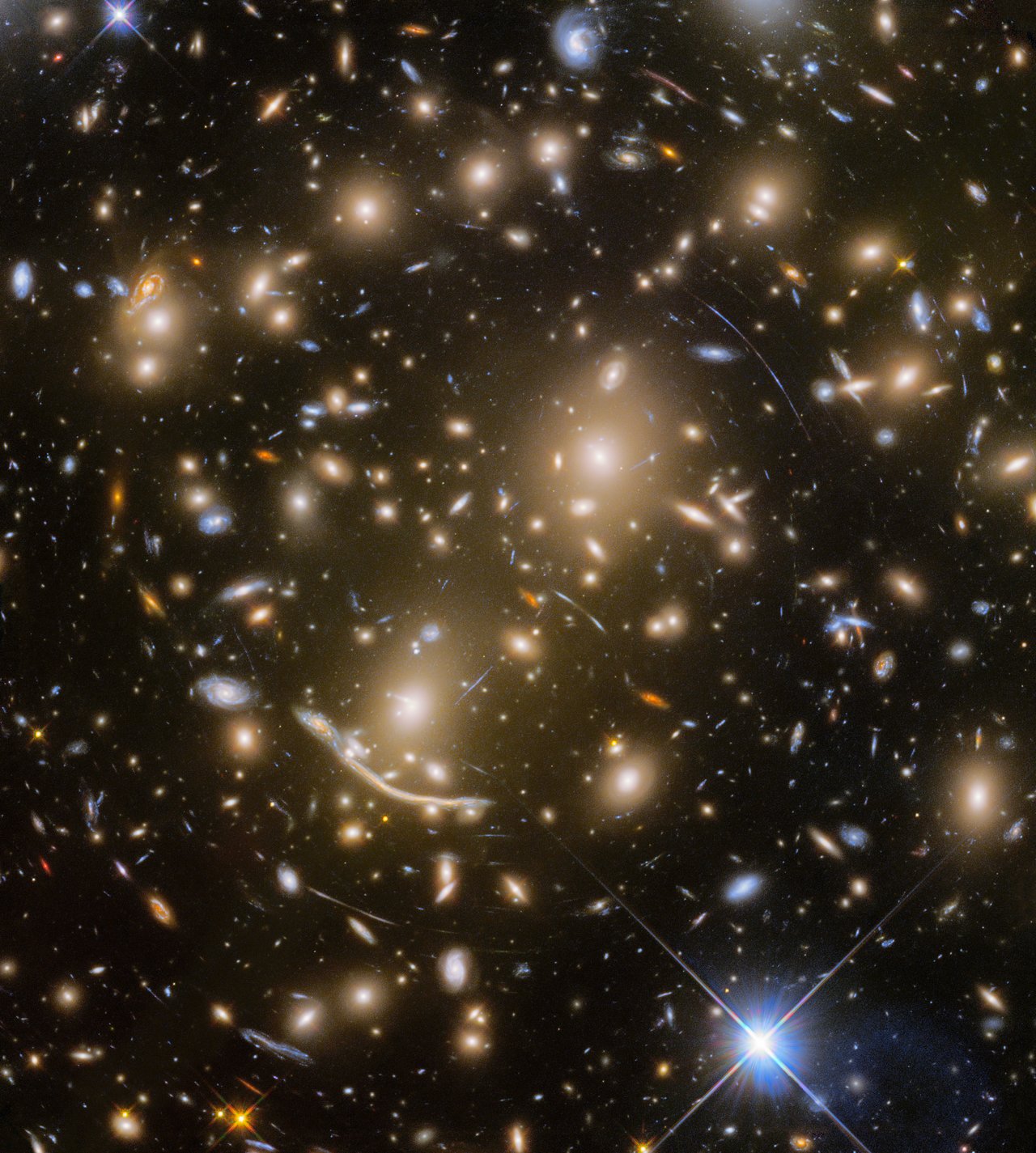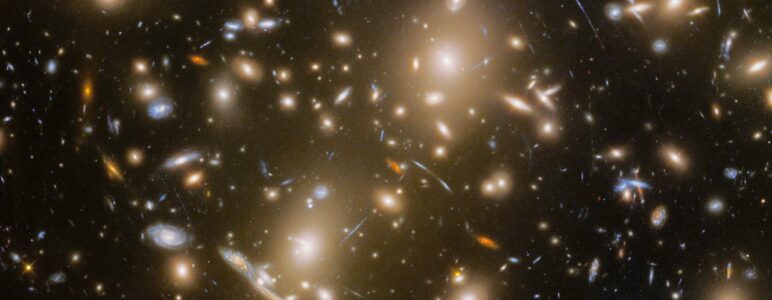The Hubble Frontier Fields program (HFF) is a remarkable venture undertaken by NASA with the goal of pushing the boundaries of how far we can see into the universe and understanding the earliest galaxies. Initiated in 2013, this ambitious program leverages the power of the Hubble Space Telescope in conjunction with other space telescopes to peer deeper into the universe than ever before.
The main purpose of the Hubble Frontier Fields program is to explore and understand the deepest parts of the universe and the earliest periods of galaxy formation by observing extremely distant galaxies. This is achieved through the innovative use of gravitational lensing, where the gravity of massive galaxy clusters magnifies and distorts the light from more distant galaxies that lie behind them. This allows astronomers to study galaxies that are otherwise too faint and remote to be seen with current technology.
Specifically, the program aims to:
- Capture Images of the Earliest Galaxies: By observing these distant galaxies, the Hubble Frontier Fields program seeks to provide insights into the galaxies as they existed just a few hundred million years after the Big Bang.
- Study Galaxy Formation and Evolution: The data collected helps scientists understand how galaxies form and evolve over time, especially during the early universe.
- Investigate Dark Matter: The program also provides an opportunity to study the properties and distribution of dark matter, which is essential for the gravitational lensing effects observed in the galaxy clusters used in the program.
Understanding the distant universe and the formation of early galaxies through initiatives like the Hubble Frontier Fields program is crucial for several reasons, each contributing to our broader comprehension of the cosmos and our place within it:
- Fundamental Knowledge of the Universe: Exploring the earliest galaxies helps us understand the universe’s origin, structure, and evolution. This knowledge is fundamental to physics and cosmology, as it directly relates to the conditions following the Big Bang and the subsequent development of the universe.
- Testing and Refining Theories: Observations from such deep-field studies test and refine our existing theories of physics and astronomy. For example, seeing how galaxies and structures formed in the early universe allows scientists to test predictions made by the Big Bang theory and the theory of general relativity, particularly concerning dark matter and dark energy, which constitute most of the universe’s mass and energy.
- Technological Advancements: The challenges of observing the most distant galaxies drive technological innovations in telescope and sensor design, data processing, and other fields. These advancements often find applications in other areas of science and technology, leading to broader societal benefits.
- Inspiration and Education: Space exploration and understanding the cosmos have a profound impact on culture and education, inspiring current and future generations to engage in science, technology, engineering, and mathematics (STEM) fields. The awe and wonder generated by space exploration foster a global perspective and a sense of shared destiny among people.
- Cosmological Parameters: Deep field observations help determine cosmological parameters with greater accuracy, such as the rate of expansion of the universe, the age of the universe, and the distribution of galaxies across various stages of cosmic history. These parameters are crucial for our complete cosmological model.
- Existential and Philosophical Implications: Knowing more about the universe’s beginnings and its eventual fate provides context for philosophical and existential inquiries about human existence and our place in the cosmos. It challenges us to think beyond our planet and consider broader questions about life, existence, and the universe’s vastness.

What technologies are being used for this project
The Hubble Frontier Fields program utilizes a variety of advanced technologies and techniques to achieve its goal of observing the most distant galaxies in the universe. Here are some of the key technologies involved:
- Hubble Space Telescope (HST): The core instrument in this program is the Hubble Space Telescope itself, which is equipped with powerful cameras and spectrographs that capture light across a wide range of wavelengths from ultraviolet to near-infrared. HST’s high-resolution imaging capabilities are crucial for observing the fine details of distant galaxies magnified by gravitational lensing.
- Advanced Camera for Surveys (ACS) and Wide Field Camera 3 (WFC3): These are two of the primary instruments on the Hubble Space Telescope used in the Frontier Fields program. The ACS is optimized for clarity and detail in visible light, while the WFC3 covers a broader spectrum, including infrared, which is essential for observing the redshifted light of distant galaxies.
- Gravitational Lensing: This natural phenomenon is used as a “cosmic telescope” to magnify the light from distant galaxies that would otherwise be too faint to detect. Massive galaxy clusters are selected as the foreground lenses which amplify the light from background galaxies, allowing astronomers to study them in greater detail.
- Data Processing Software: Advanced software is used to process the vast amounts of data collected by Hubble. This includes image processing to remove distortions and artifacts, data enhancement to improve the visibility of faint objects, and analysis tools to interpret the light from these distant galaxies in terms of their physical properties like mass, age, and composition.
- Collaborative Platforms: Given the global interest and collaborative nature of the program, various technological platforms are used to share data and findings with the scientific community worldwide. This ensures that data from the Hubble Frontier Fields program can be accessed and used by researchers to make further discoveries.
- Supporting Observations from Other Telescopes: Observations from other telescopes, such as the Spitzer Space Telescope and the Chandra X-ray Observatory, complement the data collected by Hubble. These telescopes provide additional information across other parts of the electromagnetic spectrum, offering a more comprehensive view of the galaxy clusters and the background galaxies they magnify.
These technologies together allow the Hubble Frontier Fields program to explore the edges of the observable universe, providing insights into the most distant galaxies and helping astronomers understand the early universe’s conditions and evolution.
The Power of Gravitational Lensing
At the heart of the HFF is the concept of gravitational lensing, a phenomenon predicted by Einstein’s theory of general relativity. Gravitational lensing occurs when a massive object, like a galaxy cluster, bends the fabric of space-time, magnifying and distorting the light from objects behind it. This natural cosmic lens allows astronomers to study galaxies that are farther away, and therefore older, providing a glimpse into the early stages of the universe.

The HFF specifically targets six massive galaxy clusters to take advantage of their gravitational lensing effects. These clusters act as natural telescopes, revealing the faint galaxies that lie behind them. This method has allowed scientists to observe some of the most distant galaxies known, seen as they were just a few hundred million years after the Big Bang.
Frontier Fields Major Discoveries and Insights
The data collected through the HFF has led to several groundbreaking discoveries. For instance, researchers have identified some of the most distant and ancient galaxies, helping to fill in gaps about galaxy formation and evolution. These observations have also provided more information about dark matter, which is largely responsible for the gravitational lensing effects observed.
The Hubble Frontier Fields program has yielded significant discoveries and insights that have deepened our understanding of the universe. Here are some of the major findings:
- Discovery of Extremely Distant Galaxies: One of the standout achievements of the Hubble Frontier Fields program is the identification of some of the most distant galaxies ever observed. These galaxies are seen as they were just a few hundred million years after the Big Bang, close to the edge of the observable universe. This discovery is crucial because it provides a direct glimpse into the formation of the first galaxies and the reionization era, a period when the universe transitioned from opaque to transparent as the first stars ionized hydrogen.
- Insights into Galaxy Formation and Evolution: The images and data from the Hubble Frontier Fields have challenged previous models of galaxy formation. Observations of young galaxies that are more massive and mature than expected at such early times suggest that galaxy formation began earlier and was more rapid than previously thought. This has led to revisions in theories about how galaxies evolve and the rate at which they form stars.
- Understanding of Dark Matter Distribution: Gravitational lensing, a key technique used in the Frontier Fields program, relies on the presence of massive amounts of dark matter within galaxy clusters. The detailed mapping of how light is bent by these clusters has provided new insights into how dark matter is distributed within them. This is crucial for understanding the role of dark matter in the structure and evolution of the universe, as it makes up about 85% of the total mass of the universe.

- Observations of Faint Galaxies Behind Galaxy Clusters: The program has successfully observed faint, background galaxies magnified by the foreground galaxy clusters. These observations have allowed astronomers to study the properties of these faint galaxies in unprecedented detail, including their shapes, sizes, colors, and luminosities, providing valuable data on galaxies that would typically be beyond the reach of current telescopes without the aid of gravitational lensing.
- Contributions to the Study of Cosmic Dawn and Reionization: By observing the most distant and oldest galaxies, the Hubble Frontier Fields program contributes significantly to our understanding of the cosmic dawn and the epoch of reionization. This era is critical in cosmic history, marking the formation of the first luminous sources that ended the “dark ages” of the universe.
- New Challenges to Cosmological Models: The unexpected findings, such as the early formation of massive galaxies, pose new challenges to cosmological models. These results push the scientific community to develop new theories or modify existing ones to explain how such massive galaxies could have formed so quickly after the Big Bang.
The Hubble Frontier Fields program continues to be a cornerstone in the field of observational cosmology, providing invaluable data that propels our understanding of the universe’s early days and the fundamental processes that have shaped its evolution.
Collaboration and Data Sharing
A key aspect of the HFF program is its collaborative nature and the emphasis on data sharing. The data obtained from the Hubble Space Telescope is made available to the scientific community worldwide, fostering a collaborative environment where multiple research groups can conduct further analysis and verification of findings. This approach not only accelerates scientific discovery but also enhances the transparency and reproducibility of research.
The Legacy of HFF
The Hubble Frontier Fields program represents a significant milestone in astronomical research. By combining advanced space telescopes and the natural phenomenon of gravitational lensing, HFF has expanded our view of the universe and deepened our understanding of its earliest phases.
Looking ahead, the insights garnered from the HFF will provide a valuable foundation for future observatories, such as the James Webb Space Telescope (JWST). With its more advanced technology, the JWST will extend the work of the HFF, probing even deeper into the universe and uncovering more about the mysteries of cosmic origins.
In conclusion, the Hubble Frontier Fields program has not only demonstrated the power of existing space telescopes but has also set the stage for the next generation of astronomical research, promising to unveil further secrets of the cosmos as we continue to look deeper into the vast, unexplored stretches of our universe.
By pursuing these understandings, we not only satisfy human curiosity but also build a foundation of knowledge that future scientific endeavors will rely upon. This continual quest for understanding is a key part of scientific progress and human development.

